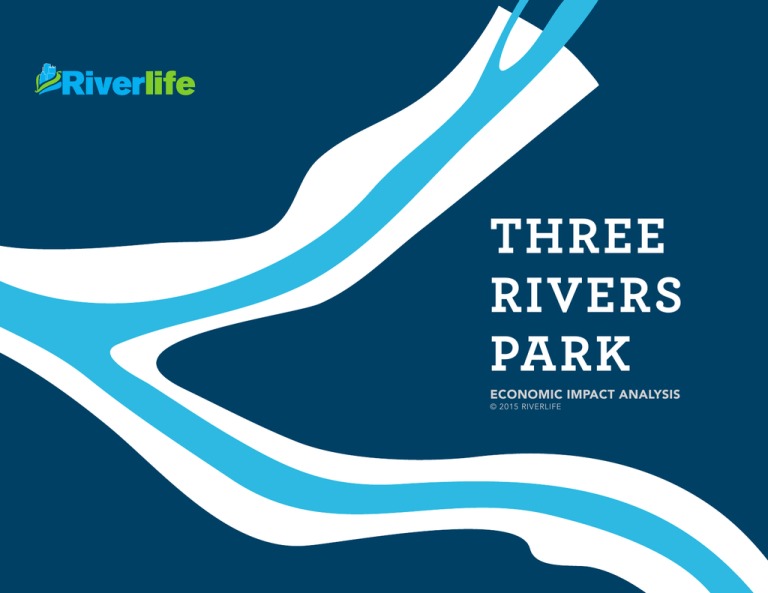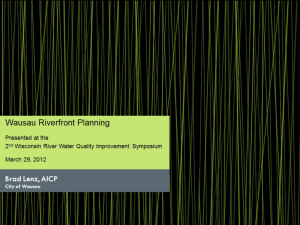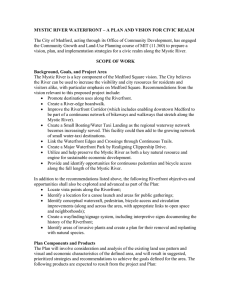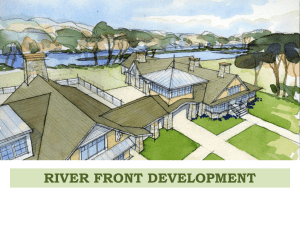Three Rivers Park Economic Impact Analysis
advertisement

THREE RIVERS PARK ECONOMIC IMPACT ANALYSIS © 2015 RIVERLIFE DO PARKS AND TRAILS GENERATE SIGNIFICANT ECONOMIC VALUE? This often-asked question elicits a variety of responses, but there is a body of evidence that suggests that they do, especially when these public realm projects are executed at a high level of quality. Riverlife contracted Sasaki Associates to use a rigorous and quantifiable approach to answer this question by analyzing the economic benefits of Three Rivers Park in Pittsburgh. Three Rivers Park is Pittsburgh’s 13-mile interconnected downtown riverfront park system. This analysis summarizes key findings and makes a meaningful link between investments in park infrastructure along Pittsburgh’s riverfront and the ability to catalyze development, increase property value, and maximize other community benefits within neighboring zones. 1 METHODOLOGY A two-pronged methodology was used to assess the demonstrated impact of public realm investments on nearby property values and economic activity. The first method analyzed transformative park and trail system improvements in four US cities to quantify the extent to which public realm investments could be linked to significant redevelopment activity. The second method analyzed what has occurred in Pittsburgh as a result of the last 15 years of public realm investment along the riverfront. Investments were analyzed and compared to the amount of catalyzed development activity within close proximity to the riverfront. A critical aspect of the analysis was to understand how property values in areas adjacent to the park improvements outpaced other areas within the City of Pittsburgh. With this finding, public officials and private leaders can weigh the return on investment for public realm infrastructure on riverfront sites. The outcome of the analysis quantifies how much economic activity is projected to be generated from future investment in the Three Rivers Park system. Using the demonstrated impacts in Pittsburgh and other cities, the analysis estimates the amount of development activity that could be catalyzed through a $50 million investment for improved parks and trails in the Strip District. Additionally, the increase in future tax revenues tied to growth in economic activity from new residents, employees, and visitors is also considered, as are other benefits to the community. 2 NATIONAL PRECEDENTS FOR THREE RIVERS PARK ROSE KENNEDY GREENWAY Boston, Massachusetts THREE RIVERS PARK Pittsburgh, Pennsylvania SMALE RIVERFRONT PARK Cincinnati, Ohio 21ST CENTURY WATERFRONT Chattanooga, Tennessee BELTLINE Atlanta, Georgia 3 EVIDENCE Atlanta BeltLine; Atlanta, Georgia Rose Kennedy Greenway; Boston, Massachusetts Smale Riverfront Park; Cincinnati, Ohio 21st Century Riverfront; Chattanooga, Tennessee Public Space Total Cost (To Date) Development Catalyzed ROI Ratio Property Value % Increase Smale Riverfront Park $88M $750M 9:1 37% (2008–2013) Atlanta BeltLine $400M $2,400M 6:1 24% (2002–2005) 21st Century Waterfront $120M $2,000M 17:1 27% (1995–1999) Rose Kennedy Greenway $35M $1,400M 40:1 49% (2005–2009) A review of existing precedents in other US cities shows that public realm investment has a high return on investment (ROI). The case studies selected as part of this analysis include Smale Riverfront Park in Cincinnati, 21st Century Waterfront in Chattanooga, the BeltLine in Atlanta, and the Rose Kennedy Greenway in Boston. These projects were chosen because of their similarity to Three Rivers Park in terms of the scale, context, and physical features of the park systems. The table below compares costs with catalyzed development and changes in property value. These metrics indicate that the value created by each of these projects far exceeds their cost, suggesting significant opportunity for comparable returns from riverfront investment in Pittsburgh. 4 .6 $4 .1 C A B inside zone of influence (ZOI) 5 B outside zone of influence (ZOI) r iv erf B ro n tm ent $2 THREE RIVERS PARK PAST SUCCESS 9M r iv e t and i nv es $ 12 r f ron t ad jace n t CATALYZED DEVELOPMENT A Rivers Casino, 2009 $10,000,000 B Point State Park Renovations, 2013 $41,200,000 C Convention Center Riverfront Plaza, 2011 $8,250,000 The Pittsburgh waterfront has already undergone an incredible transformation in recent years. This includes several major development projects, some of which are highlighted here. The focus on these not only underscores Pittsburgh’s many waterfront successes, but also provides an empirical basis for projecting benefits of future investment. Overall the approximately $130 million invested in Three Rivers Park over the past 15 years has helped to catalyze nearly $2.6 billion in riverfront development activity, and nearly $4.1 billion in total riverfront and adjacent development. Just analyzing the $2.6 billion riverfront yield, the ratio between park investment and riverfront development is 20:1. This is the high end of what has been achieved in comparable cities, and speaks to the strong success that has been accomplished along Pittsburgh’s waterfront. 6 PROPERTY VALUE IMPACTS Outside Zone of Influence (ZOI) NORTH SHORE CENTRAL BUSINESS DISTRICT SOUTH SIDE STATION SQUARE inside zone of influence (ZOI) 7 outside zone of influence (ZOI) INCREASED PROPERTY VALUE 117% 60% South Side 65% North Shore 25% Central Business District inside ZOI Studying actual historical changes in property value since 2001, the data shows a 60% property value increase within the vicinity of riverfront investment projects compared with a 32% property value increase citywide outside the riverfront zone of influence (ZOI). The pattern in Pittsburgh and in other cities across the country is clear: properties with close proximity to high quality park infrastructure increase in value more than properties that do not. This pattern of increased property value holds true when looking at individual sites as well; they perform at least twice as well—if not better— than the city average in terms of long-term increases. For example, the analysis shows that property values have increased by 117% since 2001 in the South Side, a historically underdeveloped area proximate to the waterfront. This rate of growth far outpaces the average across the city. 32% outside ZOI Property Value Impacts Median Value Increases 8 PROPOSED STRIP DISTRICT DEVELOPMENT 1 A Model for Three Rivers Park Investment 6 8 ELS 3PARC inside zone of influence (ZOI) 9 outside zone of influence (ZOI) ANNUAL TAX REVENUE This study projects the impacts of a $50 million investment in waterfront-oriented public realm improvements in the Strip District neighborhood—the rapidly developing area along the Allegheny River in Three Rivers Park. Three different scenarios estimating future value generation from tax revenue were used, informed by ratios comparing public costs of improvements to catalyzed development value from recently completed projects in Pittsburgh and other cities. $3.3M Project Cost Per Year Yearly Bond Payment The charts compare annual economic value creation with the bond payments required to finance the assumed investment. The estimated tax revenue projections range from $6.8 million to $15.6 million annually. At these levels the estimated revenue generated more than offsets the estimated annual debt payment of $3.3 million to the city. This is a conservative estimate assuming the entire project is bond financed. Total Project Annual Impact $50,000,000 investment in Strip Riverfront Park corresponds to a $3,300,000 yearly bond payment Annual Tax Revenue Streams Local Service Payroll Expenses RE-Transfer Sales Wages Property LOW $6.8M annual tax revenue MEDIUM $10.2M annual tax revenue HIGH $15.6M annual tax revenue 10 A If the first inch of rainfall per storm was captured in the proposed open space, approximately 49 million gallons of water could be captured annually, representing $16 million in annual water treatment savings.1 B The 57,000 Pittsburgh residents living within a mile of the Strip District would collectively save up to $17.1 million annually in health savings through the use of parks for exercise.2 C Within the proposed open space, each tree would remove between 300 to 700 pounds of carbon annually.1,3 D The proposed open space improvements in the Strip District would add approximately 15 acres of new open space and 1.5 miles of new trails. The additional recreational activity in the park will generate $3 million annually in direct uses, which include running, walking, and in-line skating.1,2 E The projected ridership along the Allegheny riverfront trail is expected to reach up to 2,105 riders per day, which would reduce up to 300,000 vehicle miles travelled (VMTs) per year and save 112,100 kgeCO2.1 1, 2, 3 11 sources listed on p. 16 C Carbon Sink A Stormwater B Public Health STRIP DISTRICT RIVERFRONT PARK Additional Community Benefits E Mobility Enhancements and Congestion D Recreational Amenity This study focused on the economic value of public realm investment— the question of whether, and to what extent, these investments pay for themselves. The findings strongly indicate that a well-planned investment can have a multiplier effect on economic value creation that definitively justifies its cost. The benefits of these kinds of investment, however, go far beyond the economy. They enhance a region’s cultural trust, perception, public health, physical environment, and mobility options, among other benefits. A holistic consideration of all of these factors is essential for an accurate cost-benefit analysis of public realm investment options. 12 WHAT FUNDING STRATEGIES MAKE SENSE FOR FUTURE RIVERFRONT PARK IMPROVEMENTS? In order to fund future capital improvements along the riverfront, it is recommended that four funding sources be pursued: 1. 2. 3. 4. 13 External Value Capture—TIF (tax increment financing) and BID (business improvement districts) Private Contributions—private developers, foundations, individuals, and corporations Public Funding—state and federal loans and grants Earned Income—concessions, user fees, special events, and programming FUNDING STRATEGY During the last several years of fiscal restraint, there has been a notable trend: the public sector is increasingly reluctant to fund operating and maintenance costs for public realm projects in perpetuity. Public officials have pushed project sponsors to find alternative sources of operating funds. Here, earned income from activities such as concessions and special events has played a progressively larger role in raising revenue. External value capture is probably the most untapped resource for funding public realm projects. While TIF (tax increment financing) and BID (business improvement districts) are well utilized for funding urban redevelopment projects and maintaining urban districts, they are underutilized in the public realm. Several high profile projects have leveraged these mechanisms—including Millennium Park in Chicago (which used TIF funds) and Bryant Park in New York (which employed BID)—but the vast majority of public projects have not. There is enormous potential for public realm projects nationwide to take advantage of external value capture. By concurrently considering planning, design, and economics, Pittsburgh can not only fund public realm projects in new ways, but also create enormous utility for end users and boost the value of surrounding properties. 14 RIVERFRONT PARK IMPROVEMENTS IN THE CITY OF PITTSBURGH WILL YIELD A SIGNIFICANT RETURN ON INVESTMENT 15 A rigorous analysis of the impact of park improvements in Pittsburgh and other US cities shows public realm investments yield significant return on investment by catalyzing new development in adjacent areas and helping to meaningfully increase property values. This finding is significant because it reveals that in many cases public realm projects do indeed pay their own way. The ability of parks to create value must be explicitly acknowledged and should play an important role in discussions around capital and operational funding for future park projects. PRECEDENTS SECTION CREDITS (pp. 3-4) OTHER BENEFITS SECTION CREDITS (pp. 11-12) 1. 1. 2. 3. 4. 5. 6. 7. 8. Atlanta BeltLine. Atlanta BeltLine 2030 Strategic Implementation Plan. December 2013. Federal Highway Administration. “Chattanooga, Tennessee—Riverfront Parkway.” 2014. Gentles, Coleen. “Park Conservancy Models.” City Parks Blog. 2012. HR&A Advisors, prepared for Boston Redevelopment Authority. Rose Kennedy Greenway: Creating Long-Term Value. 2010. Immergluck, Dan. The BeltLine and Rising Home Prices. Georgia Stand-Up. 2007. Eichenthal, David and Tracy Windeknecht. “A Restoring Prosperity Case Study: Chattanooga, Tennessee.” Metropolitan Policy Program at the Brookings Institute. 2008. Vaughen, Laurie Perry. “Take Me to the River.” Parks and Recreation. 2000. Rose Kennedy Greenway Conservancy. “Facts about the Greenway Conservancy” presentation. February 7, 2012. 2. 3. Sasaki Associates, prepared for the City of Pittsburgh. Allegheny Riverfront Green Boulevard Strategic Plan. 2013. Trust for the Public Land. Measuring the Economic Value of a City Park System. 2009. USDA Forest Service. i-Tree Streets (v.5.1). 2014. PHOTO CREDITS 1. 2. 3. 4. 5. Point State Park: © Bridget Winters 2013 Atlanta BeltLine: Atlanta BeltLine, Inc. Rose Kennedy Greenway: Tim Grafft/MOTT licensed under CC BY-ND 2.0. Smale Riverfront Park: © Craig Kuhner, 2013. 21st Century Riverfront: River City Company. 16


